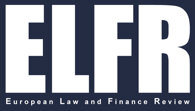ISSN: 2975-0911
© ELFR - European Law and Finance Review
Rivista di Classe A

EDITORIAL CRITERIA
Authors who wish to submit their articlesto the editorsfor publication within the Review should comply with the following requirements. The rules and editing criteria below are necessary to ensure overall uniformity. Should you have any doubts, please do not hesitate to refer, via e-mail, to the review editors. All articles received from the editorial office are submitted for refereeing according to the criteria of double-blind peer review, for any other information please see the consult the Code of Ethics.
1. GENERAL RULES
- Each article should have a title preferably of maximum ten words;
- The author's name and academic or professional qualification (one qualification only, preferably academic) should be included at the bottom of the title;
- Articles must not exceed 180 thousand characters, including spaces and notes;
- The font to be used is Garamond, 12 justified with 1.5 line spacing;
- Page or section breaks should NOT be included in the text;
- The text, even if submitted after post-reference edits, should not be in "review" or "comments" mode;
- Each article must be accompanied by a table of contents;
- Paragraph headingsshould be repeated in bold type at the beginning of each paragraph; - No bold font parts should be included in the text. Bold font is reserved for paragraph titles or subparagraphs;
- Each article must be accompanied by five-line abstracts both in Italian and English and, if necessary (in addition) in the language in which the contribution is written;
- Each article must be accompanied by five keywords both in Italian and English and preferably (in addition) in the language in which the contribution is written;
- Articles should be submitted in editable formats (no pdf);
- The scientific category should be indicated for each contribution submitted: essay, case notes, review. The journal does not publish topical contributions or contributions without the scientific required characteristics, unless expressly requested by the editors;
- Accents on upper- and lower-case lettersshould never be apostrophes.
2. FOOTNOTES
- Texts must be accompanied by footnotes (NO endnotes);
- The font to be used is Garamond, 10 justified with 1.0 line spacing;
- Citations should follow the European mode (NO American model);
- For book, volume and article citations follow this template:
o Books: N. LAST NAME, Book title, Publishing house, City, Year, p. 20 (or pp. 18-22);
o Book Chapter: N. LAST NAME, Chapter title in N. LAST NAME (ed.), Book title, Publishing house, City, Year, p. 110 (or pp. 108-122);
o Review article: N. LAST NAME, Article title, Review title, n. 1, 2022, p. 10 (or pp. 20-36);
- If a work is cited more than once, the subsequent citations should be included as follows: please indicate the beginning of the abbreviated title in italics followed by “cit.” and the page(s) number (e.g., F. GALGANO, Manuale..., cit., p. 110). If the same work is referred to in a later footnote: “op. cit.” (italics) and page number. If the same work is referred to in two successive notes: “Ibid” and page number.
o F. GALGANO, Manuale, op.cit., p. 80;
o Ibid., p. 32.
- Internal references to chapters, paragraphs, pages, footnotes, etc. should be included as follows: (i) “supra” (italics), if referring to a place that precedes, (ii) “infra” (italics) if referring to a place further;
- It will be published also articles that don't have the initial letter of the name of the author before the surname.

